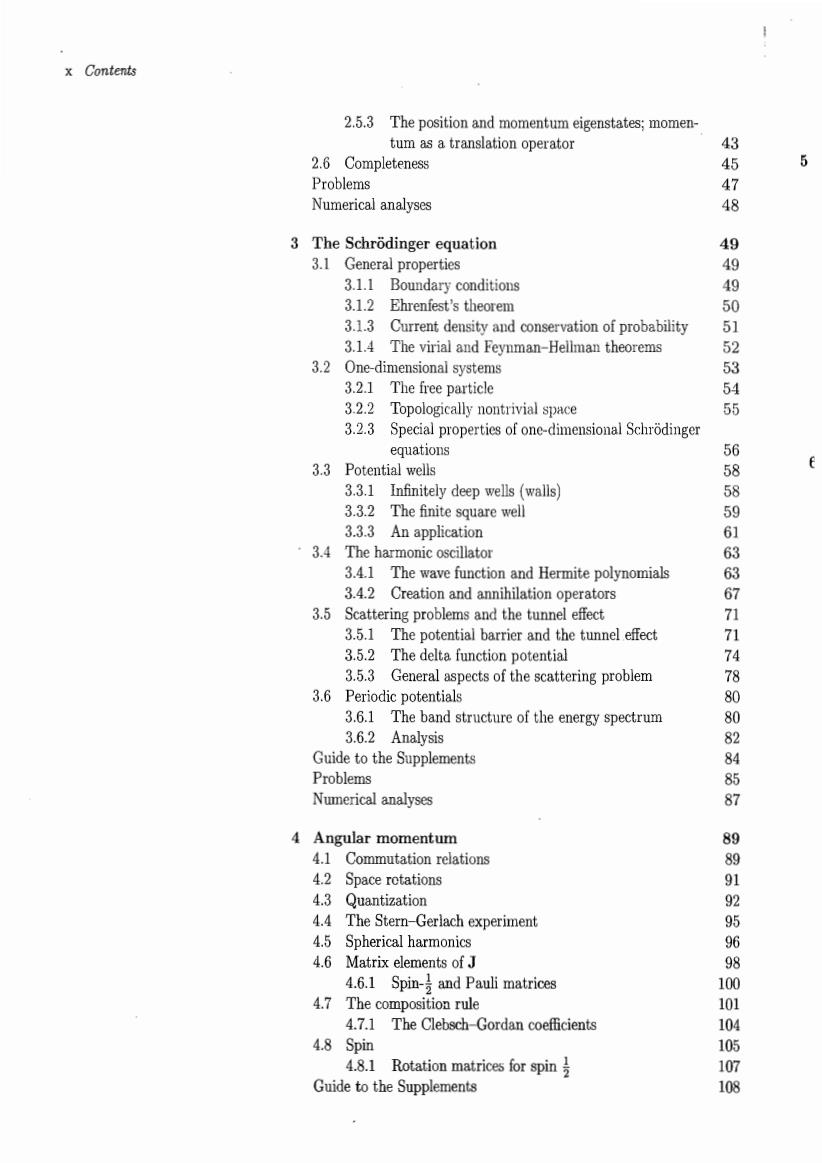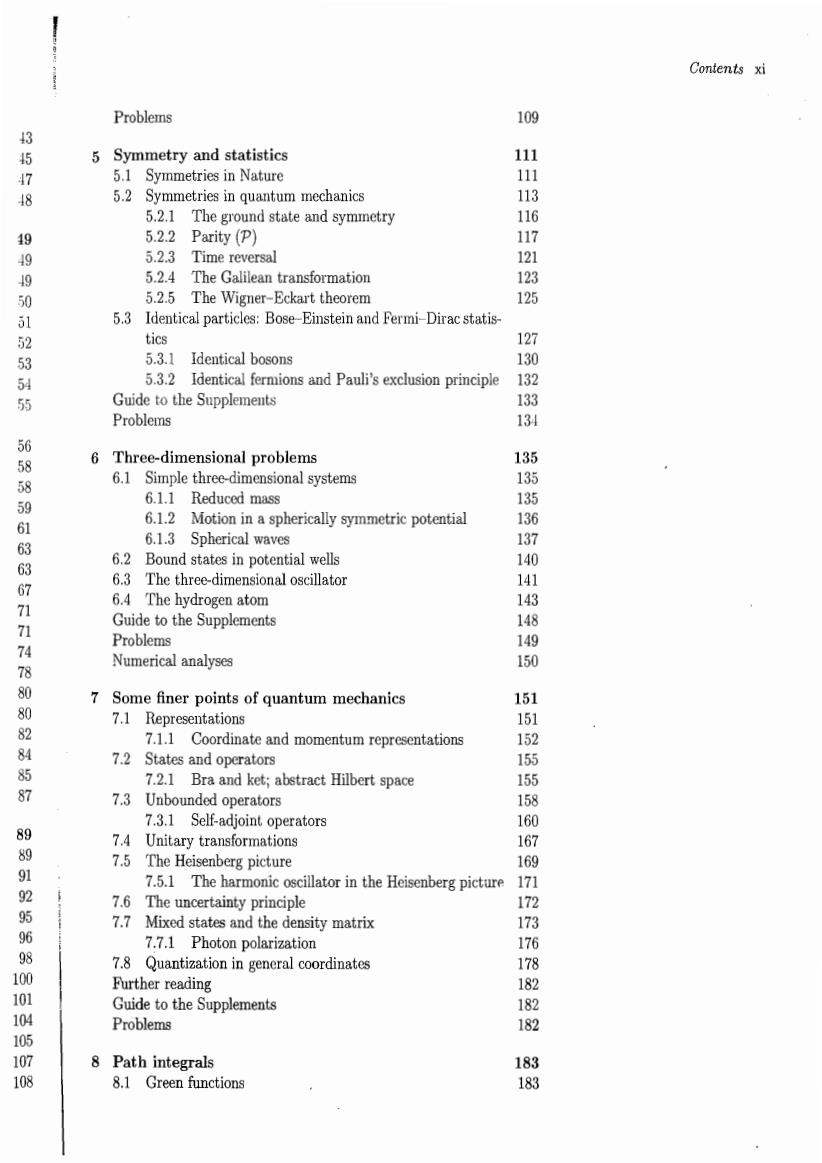
vii Preface ours and ours only,Thak are de to Chrlote Gree of OUP er crisp approa to edn al help,and to Sor the senior phyaicsedtor,iorhisadnirablepetiercediringthisbokslongperiod of gestation. Our hearty gratitude goes toour friends and colleagues who helped us C at various moments and in various-small and big-ways.A short list includes:A.Bonaccorso,D.M.Brink,P.Calabrese,P.Cecchi,R.Col- lina,E.D'Emilio,A.Di Giacomo,G.Dunne,T.Elze,M.Fukugita,C. Giannessi,V.Gracco,R.Guida,R.Jackiw,F.Maccarrone,G.March- esini,M.Matone,P.Menotti,M.Mintchev,F.M.Miranda,G.Morchio, E.Onofri,L.Picasso,M.Rocca,S.Shore,A.Toncelli,M.Tonelli,A. 1月 Tonomura,P.Truini,A.Vainshtein,and G.Veneziano. A final message to all of you(especially to the young) Read and Enjoy! Pisa,February 2009 K.Konishi and G.Paffuti

Contents I Basic quantum mechanics 1 1 Introduction 1.1 The quantum behavior of the electron 1.11 Diffraction and interference visualizing the quan 1.1.2 The and identity of atoms 13 12 tum mechanic 80 From the theory of specific heat to Planck's formula 9 132 The photoelectric effect 14 1.2. Bohr's atomic model 1.2.4 The Bohr-Sommerfeld quantization condition: de Broglie's wave Further reading 18 Guide to the Supplements 18 Problems 19 Numerical analyses 2 Quantum mechanical laws 2.1 Quantum states 21 2.1.1 Composite systems 24 2.1.2 Photon polarization and the statistical nature of mechanics 24 22 The ur princip 26 2.3 The fundame 23 Theprojlectionoperatoramdstatevectorredtction 3 He oductsof operators,commutators,and compat- ible observables 2.3.4 The position operator,the momentum operator, fundamental commutators,and Heisenberg's rela- tion 3 2.3.5 Heisenberg's relations 2.4 The Schrodinger equation 37 2.4.1 More about the Schrodinger equations 3 2.4.2 The Heisenberg picture 40 The continuous spectr 40 951 The delta function 41 2.52 Ort

x Contents 2.5.3 The position and momentum eigenstates;momen- tum as a translation operator 2.6 Completeness 45 5 Problems 47 Numerical analyses 8 3 The Schrodinger equation g 3.1 General properties 3.1.1 Boundary conditions 49 3.1.2 Ehrenfest's theorem 3.13 Current density and conservation of probability 3.1.4 The virial and Feynman-Hellman the 52 3.2 One-dime 54 Topologically nontrivial 5 3.2.3 Special properties of on-dimensional Schrodinger equations 3.3 Potential wells 3.3.1 Infinitely deep wells(walls) 58 3.3.2 The finite square well 3.3.3 An application 可 3.4 The harmonic oscillator 63 3.4.2 Creation and annihilation 3.5 Scatterin and the 3.5.1 the t unnel effect 352 potentia 74 35.3 General aspects of the scattering problem 3.6 Periodic potentials 3.6.1 The band structure of the energy spectrum 80 3.62 Analysis 82 Guide to the Supplements Problems 8 Numerical analyses 4 Angular momentum 89 4.1 Commutation relations 4.2 Space rotations 4.3 Onantization 4.4 The Stern-Gerlach experiment Spherical harm Matrix e 4.6.1 4.7 The composition rule 101 4.7.1 The Clebsch-Gordan coefficients 4.8 Spin 105 4.8.1 Rotation matrices for spin Guide to the Supplements 108

Contents xi Problems try and statistics 47 es in Nature 6 es in quantum mechanics 5.2.1 The ground state and symmetry 49 5.2. Parity (P) 5.2.3 Time reversal 1 9 5.2.4 The galilean transformation 123 5.2.5 The Wigner-Eckart theorem 125 5.3 Identical particles:Bose-Einstein and Fermi-Dirac statis- tics 127 5.3.1 Identical bosons 130 5.3.2 Identical fe rmions and Pauli's exclusion principle Guide to the Supplements Problems 131 6 Three-dimensional problems 135 58 6.1 Simple three-dimensional systems 6.1.1 Reduced mass 135 6.1.2 Motion in a spherically symmetric potential 136 6.1.3 Spherical wat 6.Bound states in po 6.3 tentialels The three-dimen roge Supplement Numerical analyses 7Some fner pointsfq mechanics 7.1 at 4 Coordinate and momentum representations 7.2 s and operators 5 7.2.1 Bra and ket;abstract Hilbert space 7.3 Unbounded operators 7.3.1 Self-adjoint operators 8 7.4 Unitary transformations 7.5 The Heisenberg picture 169 7.5.1 The harmonic oscillator in the Heisenberg picture 1 7.6 The uncertainty principle 172 7.7 Mixed states and the density matrix 173 7.7.1 Photon polarization 7.8 Quantization in general coordinates 10 Further Supplements Problems 8 Path integrals Gre 183

xii Contents 82 Path integrals 11T 8.2. Derivation 822 Mode expansion 8.2.3 Feynman graphs 8.2.4 Back to ordinary (Minkowski)time 8.2.5 Tunnel effects and instantons 198 Further reading 201 Numerical analyses 202 II Approximation methods 203 9 Perturbation theory 9.1 Time-independent perturbations 011n generate levels 212 9.1.2 The Stark effect on the=2level of the hydroger 9.13 Dipoleinteractionsandpolarizabhlty 9.2 Quantum transitions 92.1 Perturbation lasting for a finite interval 9.2.2 Periodic perturbation 9.2.3 Transitions in a discrete spectrum 223 9.2.4 Resonant oscillation between two levels 225 9.3 Transitions in the continuum 226 12 9.3.1 State density 228 228 9.5 omagnetic transitions The dipole oximation diation (or stimulated)emission Spontaneous emission 9.6 The Einstein coefficients Guide to the Supplements 湖新源幼4422 Problems Numerical analyses 244 10 Variational methods 245 10.1 The variational principle 10.1.1 Lower limits 10.1.2 Truncated Hilbert space 249 10.2 Simple applications 10.21Te 1022H oscilator elementary variational calculatior 10.2.3Ths virial 10.3 The ground state of the helium Guide to the Supplements Problems Numerical analyses 262